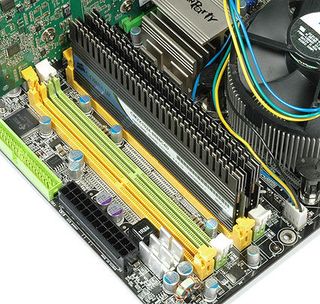Parallel Processing, Part 2: RAM and HDD
Conclusion

This second part of our article series on parallel processing dealt with single and dual channel memory, as well with the possible performance gains of upgrading a single hard drive to a RAID array with two or four hard drives. In "Parallel Processing, Part 1: CPU Cores" we analyzed where and how dual and quad core processors can increase performance, and we concluded that it makes the most sense to stick with a dual core processor for now, and only purchase a quad core if your applications can actually benefit from it. In the end, the 45 nm generation code-named Penryn is due at the beginning of next year, and it will deliver somewhat more performance at decreased power requirements.
But back to RAM and hard drives. As expected, the performance difference between single channel and dual channel DDR2-800 memory using an up-to-date Core 2 Duo system Compare Prices on Core 2 Duo Processors is little to nil, depending on the benchmark - most tests show differences, but they are really small. For games and enthusiast PCs, we recommend sticking to high-performance dual channel RAM, because the memory is one of those components that you want to perform best for a smooth experience. For regular applications, though, it doesn’t really matter much whether you run single or dual channel. Two 1 GB DIMMs typically are cheaper than a single 2 GB module, but a single DIMM will reduce your power consumption by several watts (which might just be more interesting than it is important).
It’s similar in the hard drive corner: a RAID array has to live with a marginal performance impact due to the added controller, which results in slightly decreased performance in several benchmarks. Benchmarks that actually benefit from increased storage throughput will show the best result when going from a single drive to a RAID 0 with two drives. Running four drives still increases the storage-intensive benchmarks, but the extra gains are comparatively small.
Join our discussion on this article!
Stay on the Cutting Edge
Join the experts who read Tom's Hardware for the inside track on enthusiast PC tech news — and have for over 25 years. We'll send breaking news and in-depth reviews of CPUs, GPUs, AI, maker hardware and more straight to your inbox.
-
(Firt of all: Excuse my poor English... )Reply
mmm yours memory tests don't convince me. You should run, for example, Winrar AND Lame IN PARALLEL/SIMULTANEOUS (i.e multitasking), otherwise, caches don't are flushed (and it's when dual channel really is important). Note that it's not a superflous situation; under normal use a system commonly have several huge memory applications run concurrently (word, browser whith a lot of tabs open, anti-virus, etc. )
el_bot -
hellwig I doubt anyone from Tom's will see this comment on such an old article, but it would have been interesting to see Single-vs.-Dual channel memory using an AMD processor. Since Tom's like Intel, the new Core i7's would also be beneficial. The point is, the article acknowledges the Core 2's have a tremendous amount of L2 cache to combat FSB (and consequently Memory) latencies. How is the comparison with an AMD or nwe Core i7 where there is NO FSB and the L2 Cache is significantly reduce? I would imagine this is where dual/tripple-channel shows is mustard. I hope we see a single vs. dual vs. triple channel comparison soon.Reply -
junghm69 My Windows Experience Index 3D gaming graphics score goes up from 3.8 to 5.1 when I switch from dual channel to single channel. This makes absolutely no sense. I thought dual channel was supposed to be better than single channel. Can anyone explain this?Reply
I seriously doubt that this score is accurate. I am using the built in graphics controller on the motherboard which is an AMD 760G chipset (ATI HD 3000 or 3200 I think). I've used Radeon HD 5450 video cards on similar systems and they give me a score of 5.4. How can a built in graphics controller give me a 5.1?
AMD Athlon II X3 435 Rana (2.9 ghz)
Asus M4A78LT-M motherboard
4 GB G.Skill DDR3-1333 (2x2GB) F3-10600CL9D-4GBNT CL9-9-9-24 1.5V
Windows 7 Ultimate 64-bit -
junghm69Reply
because if you used 2 different memory chips both will run at the speed of the lowest memory chip when you activate dual channel in your motherboard -
Caramac That earlier article on Processors doesn't work, so I'll add this:Reply
Intel HyperThreading - leading to the "H T" on the 'Intel Inside' sticker of computers with that 875p chipset and a single core Pentium 4 processor.
It equals simulated dual core tech.
Some Core processors also have HT.
http://www.tomshardware.com/forum/340555-28-intel-hyperthreading-helpful
Most Popular

